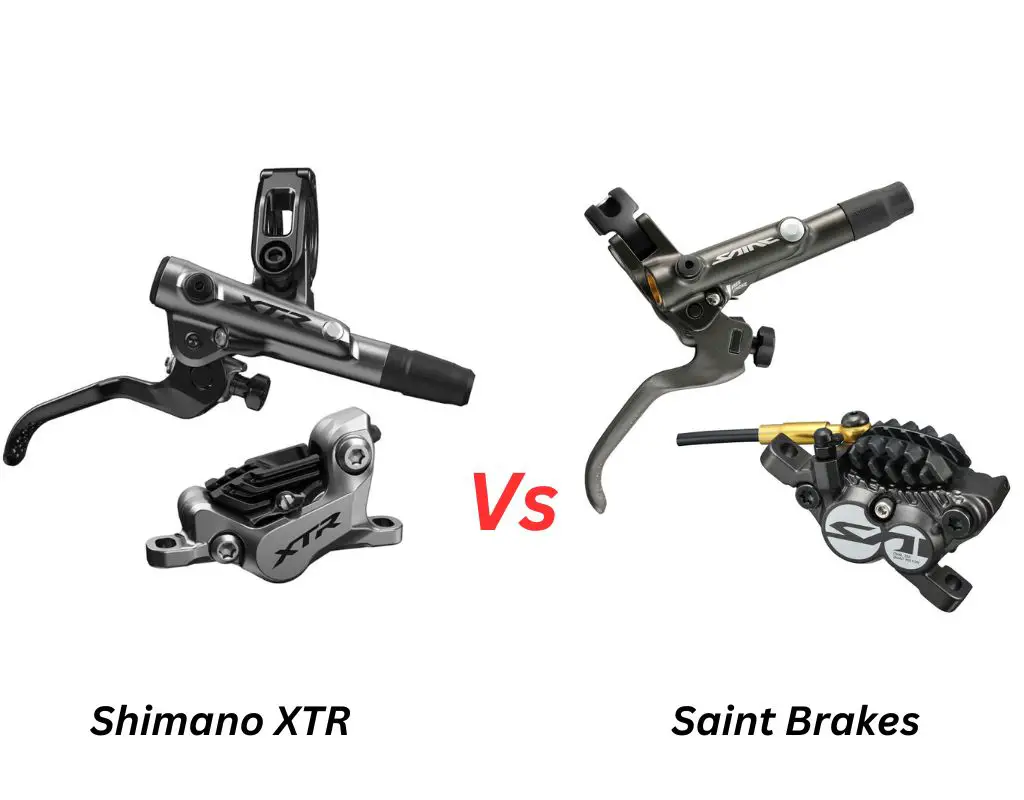
Shimano is one of the leading brands in the mountain bike brake market, offering a range of models for different riding styles and preferences.
Two of the popular options are the XTR and the Saint brakes, which cater to different segments of riders.
Below, we will compare these two brakes in terms of design, performance, features, and price.
Design
The XTR and the Saint brakes have different designs that reflect their intended use cases.
The XTR brakes are designed for cross-country (XC) and trail riding, where weight, efficiency, and modulation are important.
The Saint brakes are designed for downhill (DH) and enduro riding, where power, reliability, and durability are crucial.
XTR brakes
The XTR brakes come in two versions: the M9000 race brakes and the M9020 trail brakes. Both are 2-piston brakes with levers suited for modulated braking.
The M9000 levers have no Servo-Wave feature, which means they have a linear lever feel and a shorter lever stroke.
The M9020 levers have a more flat Servo-Wave curve, they have a smoother lever feel and a longer lever stroke.
Saint brakes
The Saint brakes are 4-piston brakes with levers designed for snappy braking. The levers have a more pronounced Servo-Wave feature, which means they have a more progressive lever feel and a shorter free stroke.
The 4-piston calipers provide more braking power and heat dissipation than the 2-piston calipers.
Related: TRP Brakes vs. Shimano Brakes: (4 Major Differences)
Performance
The XTR and the Saint brakes have different performance characteristics that suit different riding styles and preferences.
The XTR brakes are known for their light weight, efficiency, and modulation.
The Saint brakes are known for their power, reliability, and durability.
XTR brakes
The XTR brakes are among the lightest in the market, weighing around 200 grams per wheel (without rotors).
They are very efficient, requiring less finger force to achieve the same braking power as other brakes.
They have excellent modulation, allowing riders to control their braking with precision and finesse.
Saint brakes
The Saint brakes are among the most powerful in the market, delivering up to 50% more braking power than the XTR brakes.
They are reliable, withstanding high temperatures and harsh conditions without fading or failing.
They have good modulation, allowing riders to adjust their braking with confidence and ease.
Related: Magura vs Shimano Brakes: Compared
Features
The XTR and the Saint brakes have different features that enhance their performance and functionality. Some of the common features shared by both brakes are:
One-way bleeding system: This system makes bleeding easier and faster by preventing air bubbles from entering the system.
Ice-Tech technology: This technology uses metal pads with cooling fins and sandwiched rotors to reduce heat buildup and improve braking performance.
I-Spec II compatibility: This compatibility allows riders to integrate their brake levers with their shifters on the same clamp, saving space and weight on the handlebar.
Some of the features unique to each brake are:
XTR Brakes
Free stroke adjustment: It allows riders to customize the distance between the lever and the handlebar before the brake engages.
Reach adjustment: This adjustment allows riders to customize the distance between the lever and the handlebar to fit their hand size and preference.
Banjo fitting: It allows riders to adjust the angle of the hose connection to the caliper for optimal routing.
Saint Brakes
Tool-free reach adjustment: This feature enables riders to personalize the distance between the lever and the handlebar effortlessly, eliminating the need for any tools.
Tool-free pad contact adjustment: It empowers riders to effortlessly customize the distance between the brake pads and the rotor, all without the necessity of using any tools.
Ceramic pistons: These pistons reduce heat transfer from the pads to the fluid, preventing brake fade.
Related: Magura MT5 vs. Shimano XT: Compared
Price
The XTR and the Saint brakes have different price points that reflect their quality and performance.
The XTR brakes cost around $300 per wheel (without rotors), while the Saint brakes cost around $200 per wheel (without rotors). The prices may vary depending on the retailer and availability.
The XTR brakes are more expensive than the Saint brakes, but they offer more value for money for XC and trail riders who prioritize weight, efficiency, and modulation.
Conclusion
The XTR and the Saint brakes are both excellent options for mountain bike riders who want high-quality Shimano brakes. They cater to different segments of riders who have different needs and preferences.
The XTR brakes are best suited for XC and trail riding, where weight, efficiency, and modulation are important. The Saint brakes are best suited for DH and enduro riding, where power, reliability, and durability are crucial.
